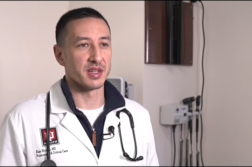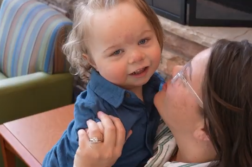ORLANDO, Fla. (Ivanhoe Newswire) — The number of reported vaping deaths in the United States has risen to 59. The youngest person is now a 15-year-old boy from Dallas and more than 2,600 people have been hospitalized with serious- or critical lung injuries from vaping. Most of those emergency room visits peaked in September but those close to this crisis say the danger is far from over.
It wasn’t the white smoke, or fruity smell that tipped off Michael Dougherty to his son’s vape use. The device itself fell out of his son’s pocket onto the floor.
Dougherty told Ivanhoe, “My initial reaction was anger. You know, how could you do this?”
Dougherty says Jimmy vowed to quit. But on September 9th, one week after his twentieth birthday, Jimmy’s health spiraled downward. After three days of vomiting and a high fever, Dougherty rushed him to the emergency room.
“And they show us the CT scan of his lungs. And you can see the damage from top to bottom throughout,” Dougherty described
Jimmy’s systems were failing. As painful as it was to watch, Dougherty snapped photos.
“He’s in this medically induced coma on a ventilator and sedated. He’s not gonna remember. He needs to see that image,” he said.
“Sometimes the lungs fail completely and you need to use a mechanical ventilation or use an ET tube to help support them on a breathing machine,” Cynthia Gries, MD, pulmonologist and Medical Director of Lung Transplant at AdventHealth Transplant Institute, said.
For some, ECMO has been a last resort. It’s a life support machine that pumps the patient’s blood to an artificial lung-sending oxygenated blood back to the body. After several weeks in the hospital, Jimmy’s lungs started to improve. He’s now working part-time and regaining his strength. Dougherty is sharing his family’s story to warn others about the dangers.
“Yes. It can happen to you,” Dougherty warned.
The CDC reported that no single substance caused the severe illnesses, but scientists have identified several marijuana products as possible causes. Dougherty says his son purchased his vapes at an established store and assumed they would be safe.
Contributors to this news report include: Cyndy McGrath, Producer; Roque Correa, Videographer and Editor.
To receive a free weekly e-mail on Medical Breakthroughs from Ivanhoe, sign up at: http://www.ivanhoe.com/ftk
MEDICAL BREAKTHROUGHS
RESEARCH SUMMARY
TOPIC: DEADLY DAMAGE FROM VAPING: RUSSIAN ROULETTE
REPORT: MB #4709
BACKGROUND: Vaping is the inhalation of a vapor created from an electronic cigarette or similar vaping device. E-cigarettes are battery-powered smoking devices, that usually connect to cartridges filled with liquid that may contain nicotine, flavorings, and other chemicals. The liquid is heated into a vapor which the person then inhales. Vaping has not been around long enough for us to know how it affects the body over time. Long-term, however, health experts are reporting serious cases of lung damage in people who vape, including deaths. Nicotine, a substance found in vaping, is highly addictive. It can slow brain development in teens and affect concentration, memory, and learning as well as attention and mood. E-cigarettes also irritate the lungs, and can lead to smoking cigarettes and other forms of tobacco use. Some people use these devices to vape marijuana, THC oil, and other chemicals. Even if they don’t have nicotine, which most do, these chemicals can irritate and damage the lungs. Because the water vapor particles are so small it appears the chemicals can penetrate deeper into the lungs than smoking a cigarette can. Experts advise not inhaling any substance other than the air you breath to ensure good health.
(Sources: https://kidshealth.org/en/parents/e-cigarettes.html, Dr. Cynthia Gries)
LUNG DAMAGE SYMPTOMS/TREATMENT: Early detection in the treatment of lung damage, disease, and cancer is critical. Look for these following warning signs: Chronic cough, shortness of breath, chronic mucus production, wheezing, coughing up blood, or chronic chest pains. If you suffer from any of these symptoms, be sure when talking to your doctor you make a list of your symptoms and note which ones bother you the most. Write down when they started and what you have done, if anything, to attempt to make them better. Treatment for lung diseases that prevent proper breathing may include things like bronchodilator medication better known as an inhaler, corticosteroids, expectorants, oxygen therapy, pulmonary rehab, and lastly, if needed, surgery.
(Sources: https://www.lung.org/lung-health-and-diseases/warning-signs-of-lung-disease/
ECMO: Extracorporeal membrane oxygenation is a treatment that involves a pump used to circulate blood through an artificial lung back into the bloodstream of a very ill patient (usually a baby.) The system provides a heart-lung bypass support outside of the body and normally may help support a child waiting for a heart or lung transplant. Now it has been found to help in teenage patients with severe lung damage, giving their lungs a chance to rest and grow healthy while they are on the ECMO. Risks associated with ECMO include blood clot formation, bleeding, infection, or transfusion problems. On rare occasions the pump can have mechanical problems such as a tube break or pump stop which could harm the patient. However, ordinarily, any patient who needs ECMO would probably die if it were not used.
(Source: https://medlineplus.gov/ency/article/007234.htm)
FOR MORE INFORMATION ON THIS REPORT, PLEASE CONTACT:
Jeff Grainger
Jeff.Grainger@AdventHealth.com
407-303-2474
FHTI.Centralized.Intake@AdventHealth.com
If this story or any other Ivanhoe story has impacted your life or prompted you or someone you know to seek or change treatments, please let us know by contacting Marjorie Bekaert Thomas at mthomas@ivanhoe.com




